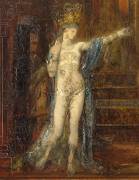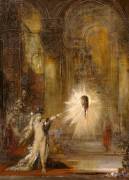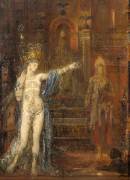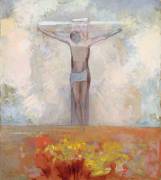Shop art print and framed art Judith and the head of Holofernes (Jodith I o Judith und Holofernes) by Gustav Klimt
Customise
Your art print
Judith and the head of Holofernes (Jodi... OF Gustav Klimt
Judith and the head of Holofernes (Jodith I o Judith und Holofernes)
The mystery surrounding Gustav Klimt's Judith and the Head of Holofernes
In the world of art, there are few works that arouse as much fascination and questioning as Judith and the Head of Holofernes by Gustav Klimt. This 1901 oil painting by the Austrian Symbolist painter has become an iconic masterpiece for all art lovers.
The biblical story of Judith and Holofernes
To understand this painting, it is essential to know the biblical story on which it is based. In the book of Judith, a Jewish widow named Judith saves her city besieged by Assyrian armies by seducing the enemy general, Holofernes. After getting him drunk, she takes advantage of his sleep to cut off his head with her sword, thus ending the siege. This story has been the subject of numerous artistic interpretations throughout history.
Gustav Klimt's bold vision
Gustav Klimt chose to depict this dramatic scene in a unique way, focusing on Judith as a symbol of feminine strength and seduction. Instead of following convention and showing Judith dressed in mourning, Klimt depicts her completely naked, wearing only jewellery and an oriental headdress. Her sensual pose and enticing gaze transform this bloody scene into a disturbingly erotic moment.
Iconographic details of the painting
In Judith and the Head of Holofernes, several elements testify to Klimt's artistic genius and mastery of painting techniques. These elements include:
- The asymmetrical composition: Judith occupies most of the space, while Holofernes's head is relegated to the lower right-hand corner, emphasising female dominance over male violence.
- The meticulous work on textures: Klimt used gold leaf and decorative motifs to create a luxurious, precious atmosphere that contrasts with the brutal act depicted.
- The colour palette: The warm, golden tones of Judith's skin contrast with the cold, dark hues of Holofernes' head, highlighting the woman's beauty and seductive power.
A symbolist masterpiece
Beyond these details, Judith and the Head of Holofernes is above all a Symbolist work, testimony to Klimt's fascination with the themes of the femme fatale and death. In this painting, Judith embodies both love and destruction, the power of seduction and violence. This duality echoes the preoccupations of the time, marked by a strong interest in psychoanalysis and the exploration of the shadowy areas of the unconscious.
The cultural impact of Judith and the Head of Holofernes
Since its premiere, Judith and the Head of Holofernes has captivated audiences and provoked numerous reactions, both positive and negative. Indeed, while some have praised the beauty and boldness of this depiction of Judith, others have criticised its provocative and erotic nature. Whatever the case, this work helped to consolidate Gustav Klimt's reputation as one of the most innovative and controversial artists of his time.
Influence on contemporary artists
Still today, Judith and the Head of Holofernes continues to inspire artists around the world, who take up and reinterpret this motif in their own creations. Whether in painting, photography or even fashion, the image of Judith beheading Holofernes remains a powerful symbol of feminine strength and the fight against oppression.
The mystery surrounding the work
Despite its success and notoriety, Judith and the Head of Holofernes remains an enigmatic work that raises many questions. These include why Klimt chose to depict Judith in such a sensual and provocative way, or how he managed to combine the themes of eroticism and death with such talent. There are many hypotheses, but no definitive answer has yet been found.
In sum, Gustav Klimt's Judith and the Head of Holofernes remains a fascinating and complex work, which continues to arouse the admiration and questions of art lovers the world over. From the biblical story to Klimt's bold artistic choices, this painting invites us to explore the twists and turns of the human psyche and the shadowy areas of our unconscious.
This artwork is a painting from the modern period. It belongs to the art nouveau styles and symbolism styles.
« Judith and the head of Holofernes (Jodith I o Judith und Holofernes) » is kept at Belvedere Museum, Vienna, Austria.











































